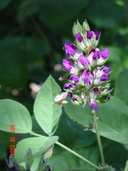Taxon Report
Hoita strobilina (H. & A.) Rydb.Loma Prieta hoita |
 © 2004 Janell Hillman |
Taxon Summary
Hoita strobilina, commonly known as Loma Prieta hoita, is a perennial herb in the Fabaceae that is found only in California. It occurs within Chaparral, Cismontane woodland, and Riparian woodland, growing at elevations from 30 to 860 meters. Hoita strobilina is ranked 1B.1, Plants Rare, Threatened or Endangered in California and Elsewhere; Seriously threatened in California.Classification
|
Scientific Name: |
Hoita strobilina (H. & A.) Rydb. |
|
Common Name: |
Loma Prieta hoita |
| Family: | Fabaceae |
| Element Code: | PDFAB5Z030 |
| USDA Plants Symbol: | HOST3 |
|
Synonyms/Other Names: |
|
Ecology and Life History
| Lifeform: | perennial herb |
| Blooming Period: May-Jul(Aug-Oct) | May-Jul(Aug-Oct) |
| Elevation: | 30-860 (100-2820) |
| General Habitats: | Chaparral, Cismontane woodland, Riparian woodland |
| Microhabitat: | Mesic, Serpentine (usually) |
| Microhabitat Details: |
Conservation Status
| CA Rare Plant Rank: | 1B.1 |
| Global Rank: | G2? |
|
State Rank: |
S2? |
| State List: | None |
| Fed List: | None |
| Other Status: | SB_CalBG/RSABG |
|
CRPR Changes: |
|
Occurrence Data from the CNDDB
| Total Occurrences: | 40 |
| Element Occurrence Ranks: | |
| Excellent (A) | 8 |
| Good (B) | 11 |
| Fair (C) | 10 |
| Poor (D) | 0 |
| None (X) | 2 |
| Unknown (U) | 9 |
| California Endemic: True | |
| California Counties and Islands: Name (Code) | |
| Alameda (ALA)*, Contra Costa (CCA), Santa Clara (SCL), Santa Cruz (SCR) | |
| Quads: Name (Quad Code) | |
| Castle Rock Ridge (3712221), Cedar Mtn. (3712155), Chittenden (3612185), Cupertino (3712231), Gilroy (3712115), Hayward (3712261), Las Trampas Ridge (3712271), Laurel (3712118), Loma Prieta (3712117), Los Gatos (3712128), Morgan Hill (3712126), Mt. Madonna (3712116), Oakland East (3712272), Richmond (3712283), San Leandro (3712262), Santa Teresa Hills (3712127) | |
Threat List Data from the CNDDB
| Threat List Total: | 13 | |
| EOs with Threat Listed: | Total EOs | % of EOs |
| 23 | 58 % | |
| Foot traffic/trampling | 8 | 20% |
| Road/trail construction/maint. | 8 | 20% |
| Non-native plant impacts | 7 | 17% |
| Development | 5 | 12% |
| Wood cutting or brush clearing | 4 | 10% |
| Insufficient population/stand size | 3 | 7% |
| Erosion/runoff | 3 | 7% |
| Other | 3 | 7% |
| Feral pigs | 2 | 5% |
| Grazing | 2 | 5% |
| Improper burning regime | 2 | 5% |
| Recreational use (non-ORV) | 1 | 2% |
| ORV activity | 1 | 2% |
Citation
California Native Plant Society, Rare Plant Program. 2025. Rare Plant Inventory (online edition, v9.5.1). Website https://www.rareplants.cnps.org [accessed 12 December 2025].